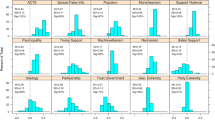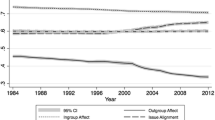Abstract
Political orientation and political attitudes were measured in two independent adult samples. One sample was taken several months before the terrorist attacks on 9/11/01; the other, shortly after. Liberal and conservative participants alike reported more conservative attitudes following 9/11/01 than before. This conservative shift was strongest on two items with the greatest relevance to 9/11/01: George W. Bush and Increasing Military Spending. Marginally significant conservative shifts were observed on two other items (Conservatives, Socialized Medicine), and the direction of change on eight of eight items was in a conservative direction. These results provide support for the motivated social cognition model of conservatism (Jost et al., 2003) over predictions derived from terror management theory (e.g., Greenberg et al., 1992).


Similar content being viewed by others
References
Aiken, L. S., & West, S. G. (1991). Multiple regression: Testing and interpreting interactions. Newbury Park, CA: Sage.
Bonanno, G. A., & Jost, J. T. (2006). Conservative shift among high-exposure survivors of the September 11th terrorist attacks. Basic and Applied Social Psychology, 28, 311–323.
Echebarria-Echabe, A., & Fernández-Guede, E. (2006). Effects of terrorism on attitudes and ideological orientation. European Journal of Social Psychology, 36, 259–265.
Gailliot, M. T., Stillman, T. F., Schmeichel, B. J., Maner, J. K., & Plant, E. A. (2008). Mortality salience increases adherence to salient norms and values. Personality and Social Psychology Bulletin, 34, 993–1003.
Greenberg, J., Simon, L., Pyszczynski, T., Solomon, S., & Chatel, D. (1992). Terror management and tolerance: Does mortality salience always intensify negative reactions to others who threaten one’s worldview? Journal of Personality and Social Psychology, 63, 212–220.
Jost, J. T. (2006). The end of the end of ideology. American Psychologist, 61, 651–670.
Jost, J. T., Fitzsimons, G., & Kay, A. C. (2004). The ideological animal: A system justification view. In J. Greenberg, S. L. Koole, & T. Pyszczynski (Eds.), Handbook of experimental existential psychology (pp. 263–283). New York: Guilford Press.
Jost, J. T., Glaser, J., Kruglanski, A. W., & Sulloway, F. J. (2003). Political conservatism as motivated social cognition. Psychological Bulletin, 129, 339–375.
Lambert, A., Scherer, L., Olson, K., Andrews, R., Schott, J. P., O’Brien, T., & Zisser, A. (2009). Attitude change and psychological threat: Towards a greater understanding of the role of anger vs. anxiety. Washington University, St. Louis, MO, Unpublished manuscript.
Landau, M., Solomon, S., Greenberg, J., Cohen, F., Pyszczynski, T., Arndt, J., et al. (2004). Deliver us from evil: The effects of mortality salience and reminders of 9/11 on support for President George W Bush. Personality and Social Psychology Bulletin, 30, 1136–1150.
McGregor, I., Nail, P. R., Marigold, D. C., & Kang, S.-J. (2005). Defensive pride and consensus: Strength in imaginary numbers after self-threat. Journal of Personality and Social Psychology, 89, 978–996.
Nail, P. R., Harton, H. C., & Barnes, A. (2008). A test of Dovidio and Gaertner’s integrated model of racism. North American Journal of Psychology, 10, 197–220.
Nail, P. R., Harton, H. C., & Decker, B. (2003). Political orientation and aversive versus modern racism: Tests of Dovidio and Gaertner’s integrated model. Journal of Personality and Social Psychology, 84, 754–770.
Nail, P. R., McGregor, I., Drinkwater, A., E., Steele, G. M., & Thompson, A. T. (in press). Threat causes liberals to think like conservatives. Journal of Experimental Social Psychology.
Rosenblatt, A., Greenberg, J., Solomon, S., Pyszczynski, T., & Lyon, D. (1989). Evidence for terror management theory: I. The effects of mortality salience on reactions to those who violate or uphold cultural values. Journal of Personality and Social Psychology, 57, 681–690.
Sales, S. M. (1972). Economic threat as a determinant of conversion rates in authoritarian and nonauthoritarian churches. Journal of Personality and Social Psychology, 23, 420–428.
Sales, S. M., & Friend, K. E. (1973). Success and failure as determinants of level of authoritarianism. Behavioral Science, 18, 163–172.
Thorisdottir, H., & Jost, J. (2009). Closed-mindedness mediates the effect of threat on political conservatism. Princeton University, Princeton, NJ, Unpublished manuscript.
Ullrich, J., & Cohrs, C. (2007). Terrorism salience increases system justification: Experimental evidence. Social Justice Research, 20, 117–139.
Author information
Authors and Affiliations
Corresponding author
Rights and permissions
About this article
Cite this article
Nail, P.R., McGregor, I. Conservative Shift among Liberals and Conservatives Following 9/11/01. Soc Just Res 22, 231–240 (2009). https://doi.org/10.1007/s11211-009-0098-z
Published:
Issue Date:
DOI: https://doi.org/10.1007/s11211-009-0098-z




